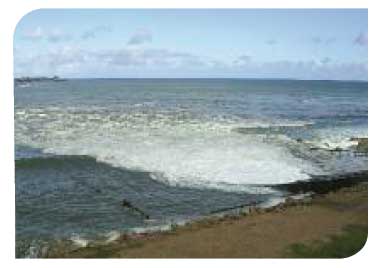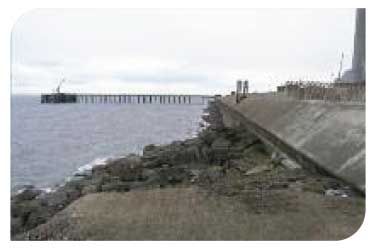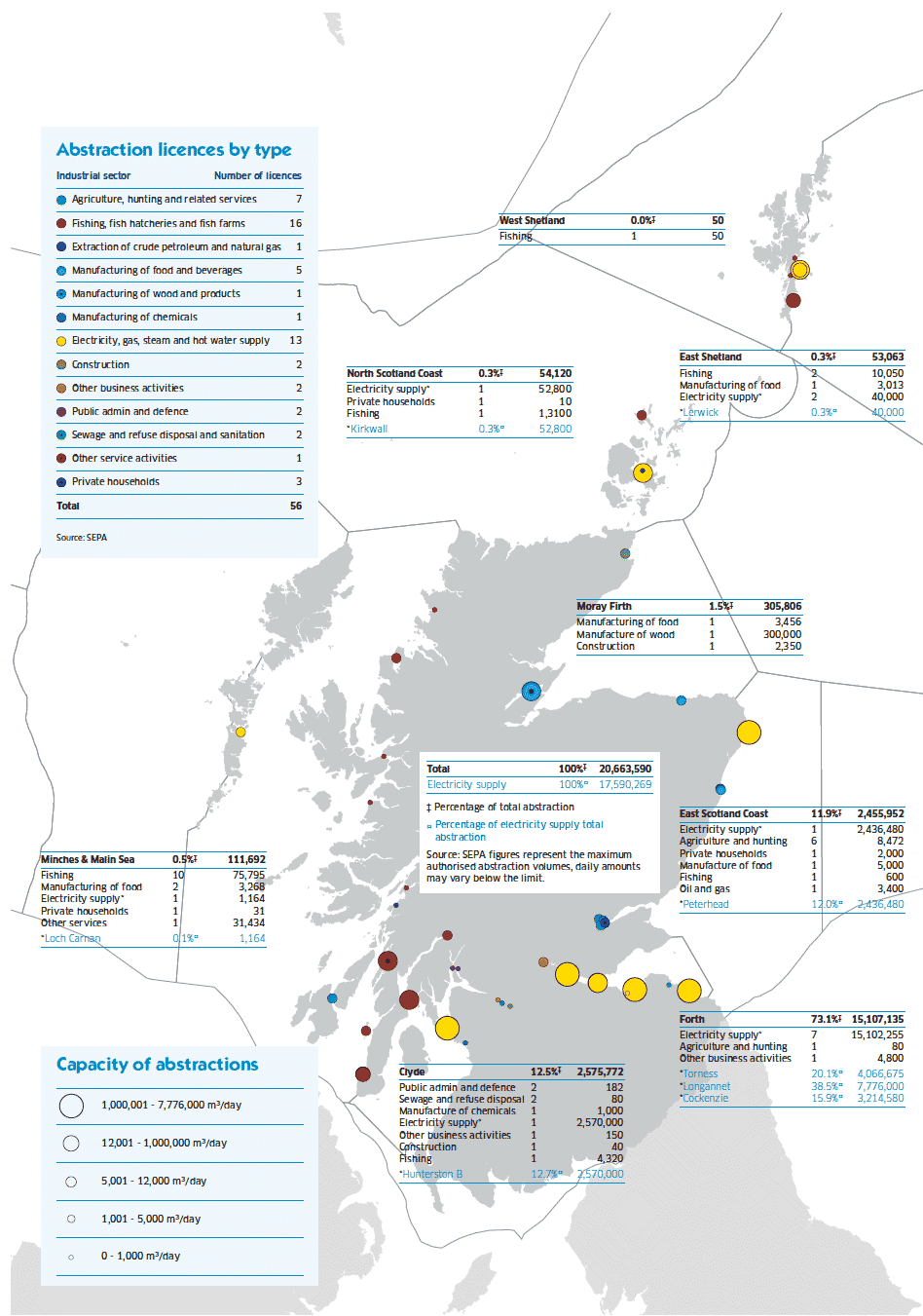Scotland's Marine Atlas: Information for The National Marine Plan
Scotland's Marine Atlas is an assessment of the condition of Scotland's seas, based on scientific evidence from data and analysis and supported by expert judgement.
WATER ABSTRACTION
What, why, where?
Abstraction involves taking water, via pipe, from the sea, using it for an industrial process and then returning it to the sea. Most abstracted water is used for cooling. There is a limit placed on the temperature at which water can be returned. The majority of coastal water abstractions, by volume, are for power stations (98% or 20.2M m 3 per day). The remainder 2% or 0.4M m 3 per day are for use by the fish processing and manufacturing industries. Cooling water used by ships is not included here.
A large power station may abstract up to 200m 3/second or more during peak load for cooling from either coastal or estuarine waters. In most cases non-evaporative cooling is used where the steam turbine exhausts are cooled via the main condensers before the water is discharged back to the sea. Evaporative cooling is often used by power stations located inland which use cooling towers to recycle the water.
Other uses include the operation of fish farms and fish processing factories, manufacture of food, wood and chemical products, agriculture, marine animal sanctuaries and navigation abstractions to maintain water levels in impounded docks. Use is also made by the construction industry (for use as a raw material) and by the defence industry.
There are 20 abstractions from transitional waters (i.e. water from estuary or river mouths that is partly salty but substantially influenced by freshwater flows) and 36 abstractions from coastal waters (i.e. waters from highest tide to 3 nautical mile limit but not transitional water). Putting this in context, the Clyde and Forth sea areas daily abstractions represent about 0.002% and 0.00045% of the volumes of the sea areas. Abstractions from the other sea areas are significantly less than these. If industry could not abstract water from the sea, the alternative would be to abstract water from rivers or land based groundwaters, if available.
Cooling water discharge at Peterhead

© SEPA
Contribution to the economy
Water abstraction can create efficiency savings but does not generate a measurable economic value by itself. It is therefore not possible to measure its contribution in terms of GVA or employee jobs. However, it is clear that such abstractions are fundamental to sustaining certain key economic activities. The Charting Progress 2 approach (1) calculates the UK annual market value of electricity sales from coastal power stations as between £5 billion and £10 billion and attributes £100-200 million to coastal station production based on a 2% energy efficiency advantage over air cooled power stations. As there are about 25% of UK stations in Scotland, a value of between £25M and £50M per annum has been estimated. There are many other industries which abstract water, and other assumptions, that have not been taken into account in the assessment of economic value. However, the valuation highlights that coastal waters have an economic value for industry, even if there is difficulty in calculating it. Given the assumptions, it would not be appropriate to split this figure between the sea areas.
Pressures and impacts on Scotland's socio-economics
Positive
- Power stations directly support the economy through the provision of electricity
- Recreational angling may benefit from wild sea bass feeding in the plume of discharged waters - anecdotal evidence from Torness power station
Negative
- Fish caught on intake grilles may reduce efficiency of industrial process
- Possible restrictions on certain uses of the sea near large intakes
Source: Based on CP2 PSEG section 3.17.6 (2)
Fish trapped at Longannet
Fish entrapment is a commercially sensitive subject and there have been few studies on the matter. 'Fish Mortality by impingement on the cooling water intake screens of Britain's' largest direct-cooled power station', estimated that nearly 1.25 x 107 (95%c.i.: 7.10 x 106 - 2.21 x 107) fish weighing almost 74 t (43.0 - 127.8 t) were trapped at Longannet Power Station in 1999. Of these, the clupeids sprat and herring comprised 85%. However, inter-annual variation can be large. At nearby Kincardine the mass of dead fish increased from 10 t between June 1961 and November 1962 to 150 t in December 1962. A fish return system is being installed at Longannet to reduce mortality and return all fish (alive and dead) to the estuary to mitigate the impact on the estuarine ecosystem (5).
Pressures and impacts on the environment
Pressure theme: Climate change and physical pressures
Pressure: Thermal changes
Impact: Water returned at higher temperatures. Not considered to be a major threat in coastal waters due to rapid mixing in coastal waters, e.g. Longannet Power Station return channel is 1.7kms long so reducing thermal effect.
Pressure: Water flow changes (local)
Impact: Changes in water flow due to water intake pipes. Any scour effects are predicted to be localised. The main impact would be the removal of species.
Pressure theme: Pollution and other chemical pressures
Pressure: Pollution
Impact: Chlorine biocides and oxidants used to limit biofouling organisms. Studies have shown that fish livers may accumulate chlorinated by-products but harmful effects have not been discovered. (3)
Pressure theme: Biological pressures
Pressure: Species level pressures
Impact: Removal of species via cooling water inflows, number of fish impinged on the intake screens is proportional to the volume of water abstracted. Biological impingement and entrainment typically consists of fish, seaweeds, jellyfish, other macro-invertebrates and planktonic species. Considered less of a threat at coastal abstractions due to larger water body.
Source: Based on CP2 PSEG table 3.118 (2) and UK Marine Policy Statement (4)
Cooling water intake at Cockenzie

© SEPA
Forward look
Water abstraction is generally important for industry and for economic growth but new development is led by the needs of industry and markets. Water abstraction is likely to continue at close to its current level and may increase in future. There is a strong possibility that electricity generation capacity will be built in future, so the need for abstraction for energy production is likely to continue even though the current emphasis is on renewable energy production. The Scottish Government's second National Planning Framework (6) identifies opportunities for generation at Longannet, Cockenzie, Boddam and Hunterston. Locations of future water intakes may need careful consideration, particularly if proposed for narrow estuaries that are important for protected habitats and species.
Coastal abstraction points by industry type and volume
Abstraction licences by type

There is a problem
Thanks for your feedback